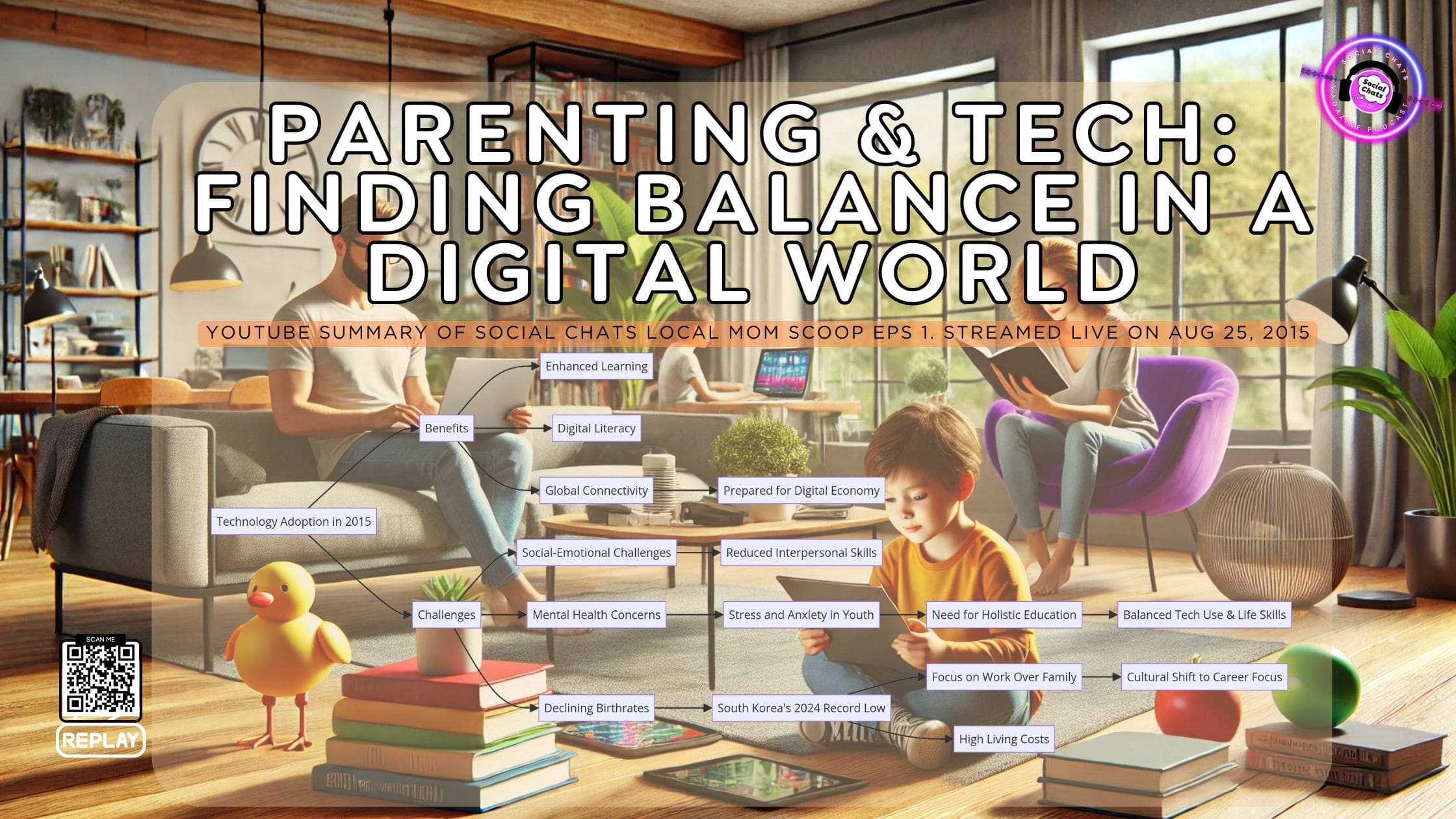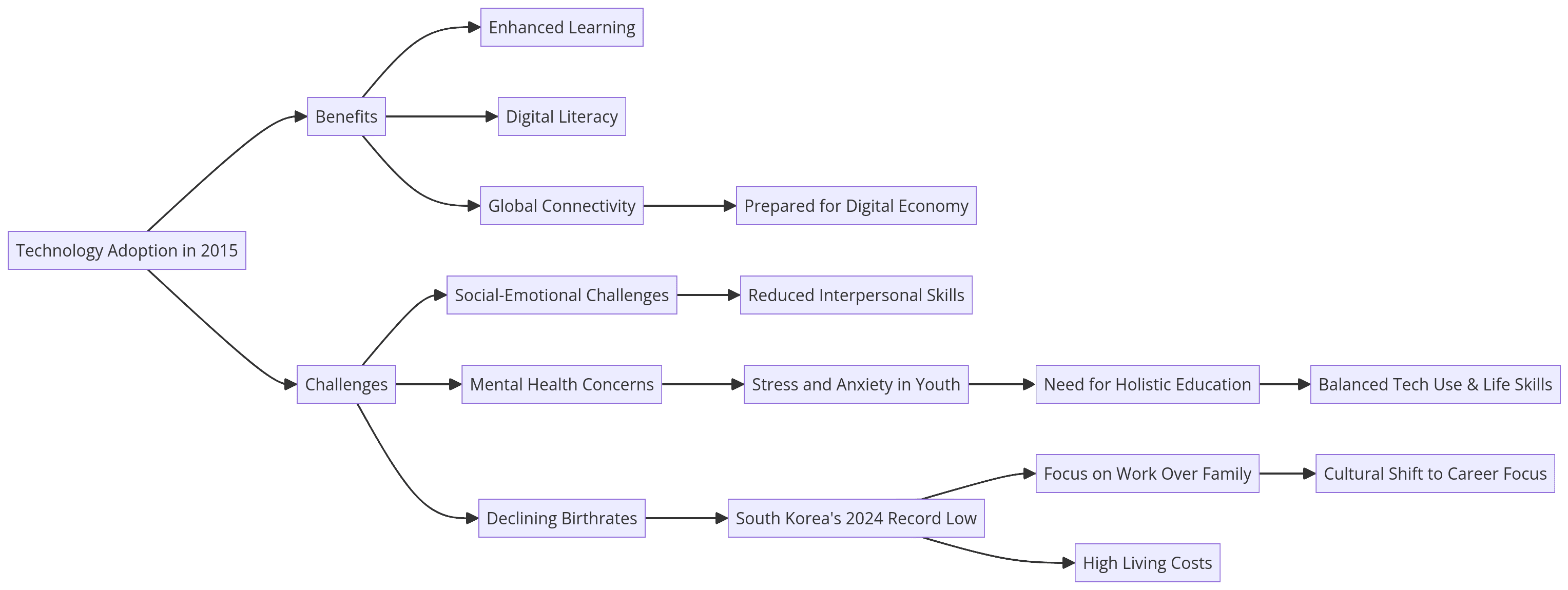

On August 25, 2015, Social Chats Local Mom Scoop aired its first episode, diving into the evolving relationship between parenting and technology. South Korea was lauded for its groundbreaking integration of tablets in education, a decision that influenced global discussions about digital learning and childhood development. Fast forward to 2024, and while the benefits of this approach are evident, South Korea faces an alarming societal challenge: a historic low birthrate. Could the emphasis on technology in childhood play a role? This blog explores the timeline from 2015 to today, analyzing how technology has shaped families and societies.
Social Chats Local Mom Scoop EPS 1
Summary
💻 Digital Overload and Privacy Concerns:
- 🌐 Discussion about being overly reliant on digital systems, tracking concerns with devices, and a desire to disconnect periodically.
- 📍 Personal anecdotes highlighting privacy intrusions, such as location tracking.
👨👩👧👦 Parenting in a Digital Era:
- 📱 Challenges in balancing technology use with parenting responsibilities.
- 🚫 Discussions on limiting screen time for children and the impact of blue light on sleep patterns.
🤒 Health and Parenting Struggles:
- 🛌 Detailed accounts of managing sick children while juggling work.
- 💤 Shared experiences about exhaustion and maintaining routines during illnesses.
📚 Educational Trends:
- 🎓 Conversations about the transition from preschool to kindergarten and increasing digitalization in schools.
- 📱 Mention of progressive education systems like those in South Korea using tablets instead of textbooks.
🌟 Community Engagement:
- 💬 Highlights of social media involvement, local events, and promotional activities.
- 💃 Mention of a flash mob event and community-driven initiatives.
⚡ Cultural Shifts in Technology and Lifestyle:
- 🚀 Observations on rapid technological adoption and its implications on future generations.
- 📖 Nostalgia for books vs. the convenience of digital formats.
😂 Parenting Humor and Realities:
- 🎒 Lighthearted takes on back-to-school routines, managing lunches, and the humor in parenting challenges.
From Tablets in Schools to Today
In 2015, South Korea became a global leader by replacing textbooks with tablets, paving the way for digital-first education. While this move boosted academic performance and prepared students for tech-driven careers, it also contributed to a hyper-competitive culture. By 2024, this societal emphasis on productivity and academic excellence has been linked to declining birthrates and increasing mental health concerns.
How Technology Shapes Child Development
- Benefits:
- Enhanced learning opportunities with interactive and personalized tools.
- Early tech skills preparing children for modern careers.
- Connectivity fostering global awareness and creativity.
- Concerns:
- Excessive screen time hindering social-emotional development.
- Reduced interpersonal interactions affecting relationship-building.
- Rising mental health challenges like anxiety and burnout in younger generations.
South Korea’s 2024 Birthrate Crisis
- Societal Pressures:
The intense focus on academic and professional success, partly driven by tech-based education, has deprioritized family life. - Changing Values:
Younger generations are prioritizing careers, personal freedom, and digital engagement over traditional roles like parenting. - Economic Strain:
High costs of living and raising children, combined with societal expectations, discourage starting families.
Lessons for the World
South Korea’s experience offers insights for balancing innovation and societal well-being:
- Education systems must pair tech integration with life skills and emotional development.
- Governments should prioritize affordable childcare, housing, and family-friendly policies.
- Societies need to value family life alongside technological and economic success.
Conclusion Diagram:
Summarizing the journey from South Korea’s technology adoption in 2015 to its challenges and societal impacts in 2024. It highlights the benefits of enhanced learning and digital literacy alongside challenges such as declining birthrates and mental health concerns, with a focus on balanced tech use and holistic education.
Insights Based on Numbers and Timestamps
- Numbers:
- South Korea’s record-low birthrate in 2024 (0.78 births per woman).
- Early adoption of tablets in schools in 2015 helped boost global rankings in STEM subjects.
- High stress levels among youth, with surveys linking academic pressure to mental health issues.
- Timestamps:
- 🎵 Introduction with Music: Host introduces the show and adjusts music while discussing tech issues and live streaming challenges.
Watch Here - 🌐 Tech and Privacy Concerns: Discussion about online privacy, GPS tracking, and concerns over being on “the grid.”
Watch Here - 📵 Digital Detox: The host shares plans to use a flip phone on weekends to disconnect from the constant buzz of social media and work.
Watch Here - 🤕 Parenting Struggles: Talk about dealing with sick kids, managing routines, and balancing work-life responsibilities.
Watch Here - 💻 Educational Technology: Conversation about South Korea’s advanced education system, moving to tablets instead of books, and the global race to improve internet speed.
Watch Here - 🍔 Local Restaurant Review: A review of PDQ, highlighting fresh food preparation and kid-friendly experiences, like making milkshakes.
Watch Here - 👗 Back-to-School Trends: Insights into kids’ fashion trends, unique backpacks, and prepping for the school year.
Watch Here - 🎥 Exploring New Platforms: Introduction to “Blab,” a platform combining video streaming and group discussions, as a tool for community engagement.
Watch Here - 💃 Flash Mob Plans: Excitement around planning a Zumba flash mob event as part of community activities.
Watch Here - 🎉 Wrap-Up and Call-to-Action: Host shares details on how to stay connected, with plans for upcoming shows and community events.
Watch Here
- 🎵 Introduction with Music: Host introduces the show and adjusts music while discussing tech issues and live streaming challenges.
Explanatory Q&A

1. Does early tech help or hinder development?
The impact of early tech use on child development is complex, with clear benefits and significant challenges. Here’s a breakdown:
How Early Tech Helps Development
- Enhanced Learning:
- Interactive tools like tablets enable personalized learning, catering to individual paces and styles.
- Digital resources provide access to a vast array of educational materials, promoting curiosity and creativity.
- Digital Literacy:
- Early exposure to technology equips children with essential skills for a connected world, such as problem-solving, adaptability, and tech fluency.
- Global Awareness:
- Technology fosters connectivity, allowing children to explore diverse cultures and perspectives through online collaboration and learning.
How Early Tech Hinders Development
- Social-Emotional Challenges:
- Over-reliance on screens can reduce opportunities for face-to-face interaction, crucial for building emotional intelligence and communication skills.
- Mental Health Risks:
- Prolonged screen use, especially social media, is linked to anxiety, attention problems, and disrupted sleep patterns due to blue light exposure.
- Physical Health Impacts:
- Excessive screen time may contribute to sedentary habits, poor posture, and eye strain.
Balancing the Benefits and Risks
- While technology like tablets and apps can support education, its overuse risks hindering essential developmental areas, including interpersonal skills and emotional well-being. Countries like South Korea, which adopted tablet-based education in 2015, have seen both academic success and societal challenges, such as increased youth stress levels and a declining birthrate by 2024.
Takeaway for Parents:
Introduce technology thoughtfully:
- Focus on educational content and limit passive screen time.
- Ensure balanced activities, including physical play and social interaction.
- Model healthy tech habits by establishing screen-free family zones and promoting offline activities.
In essence, technology is a tool; its impact depends on how it is used. Striking a balance ensures it complements rather than hinders a child’s holistic development.

2. How can parents balance tech and routines?
Balancing technology use with daily routines is essential for fostering a healthy environment for children. Here are practical strategies:
Set Clear Boundaries
- Tech-Free Zones: Create spaces where devices are not allowed, such as dining areas or bedrooms. These zones encourage meaningful interactions and rest.
- Scheduled Screen Time: Allocate specific times for technology use, such as after homework or during designated learning periods.
Encourage Purposeful Use
- Educational Tools: Promote apps and devices that enhance learning, creativity, and skill-building. For example, educational games or coding apps.
- Limit Passive Consumption: Reduce time spent on activities like binge-watching or aimless scrolling by offering engaging offline alternatives.
Be a Role Model
- Lead by Example: Demonstrate healthy tech habits by managing your own screen time. Avoid excessive phone use and show how to balance tech with real-world interactions.
- Family Tech Guidelines: Establish shared rules, such as no devices during meals or after a certain hour in the evening.
Integrate Offline Activities
- Hobbies and Physical Play: Encourage children to engage in activities like sports, puzzles, art, or reading. These help in building creativity and motor skills.
- Collaborative Tasks: Involve children in activities like cooking, gardening, or family projects to promote teamwork and reduce reliance on screens.
Monitor and Adapt
- Use Parental Controls: Many devices offer settings to filter content and set time limits, ensuring age-appropriate access to technology.
- Regular Check-Ins: Periodically review how technology fits into your family’s routine and make adjustments as needed to ensure a balanced approach.
Pro Tips for Parents
- Tech Detox Days: Dedicate one day a week for the whole family to unplug from devices. Use this time for outings, board games, or simply relaxing together.
- Blended Learning: Pair technology-based learning with hands-on activities to balance screen time with physical engagement.
Balancing technology with routines isn’t about eliminating devices but integrating them thoughtfully. By setting boundaries, promoting purposeful use, and modeling healthy habits, parents can create a harmonious environment where technology supports rather than disrupts family life.

3. What Lessons Can We Learn From South Korea’s Example?
South Korea’s adoption of tablet-based education in 2015 provides valuable insights into the benefits and challenges of early tech integration. Here’s what the world can learn:
1. The Power of Early Tech Adoption
- Academic Success:
South Korea’s students excel globally in STEM fields, thanks in part to their early embrace of digital tools in schools. Interactive and personalized learning methods have empowered students to thrive academically. - Future-Ready Citizens:
Tablet-based education has prepared South Korean students for a rapidly evolving digital economy, equipping them with tech-savvy skills from an early age.
2. The Societal Challenges of a Tech-Driven Culture
- Increased Pressure on Youth:
The emphasis on academic excellence, driven by tech-enabled tools, has contributed to high stress levels among students. This competitive culture leaves little room for creativity or emotional well-being. - Declining Birthrates:
In 2024, South Korea faces a record-low birthrate (0.78 births per woman), partly linked to societal pressures for academic and career success. Younger generations are deprioritizing marriage and family life in favor of personal freedom and professional growth. - Mental Health Concerns:
The high-stakes environment cultivated by early tech adoption has led to rising mental health challenges, such as anxiety and burnout.
3. Balancing Innovation and Well-Being
- Holistic Education:
Schools should balance technology with life skills, creativity, and social development to ensure well-rounded growth. - Supporting Family Values:
Societies need policies that make family life more accessible and rewarding, such as affordable childcare, parental leave, and flexible work arrangements. - Fostering Emotional Development:
Integrating emotional intelligence training alongside academic subjects can help students navigate the pressures of a tech-dominated environment.
4. Global Takeaways
- Adapt Technology Thoughtfully:
Countries adopting South Korea’s model should focus on moderation, ensuring that tech is a complement to traditional learning rather than a replacement. - Invest in Mental Health:
Prioritizing mental health resources in schools and communities is crucial for addressing the unintended consequences of competitive, tech-driven education systems.
South Korea’s experience highlights the transformative potential of technology in education but also underscores the importance of balance. By valuing emotional well-being and family life alongside innovation, societies can create environments where both individuals and communities thrive.
Conclusion
Parenting in the digital age is about finding harmony between tradition and innovation. South Korea’s example illustrates the transformative potential of technology while reminding us of the risks of neglecting societal and emotional well-being. As one speaker noted, “Technology is best when it brings people together, not pulls them apart.”
Call to Action:
Join the conversation! Share your thoughts on how we can balance technology and tradition for the next generation.
*Disclaimer: Youtube Video Summary Of Social Chats Local Mom Scoop EPS 1. Live streamed August 25, 2015. This Summary/ Long Form Blog Was Created With The Assistance Of AI Language Model ChatGPT By OpenAI.
WRITTEN BY
Social Chats
Social Chats is a multimedia and entertainment company. It’s a division of kNOw Aging, inc. a communications consultancy.










